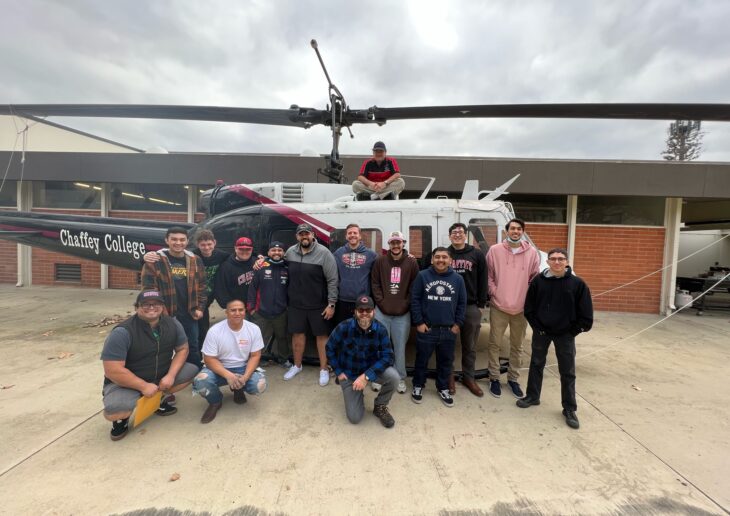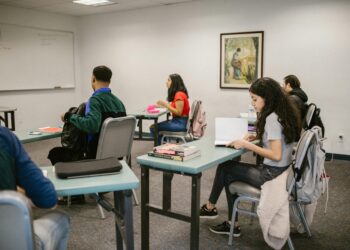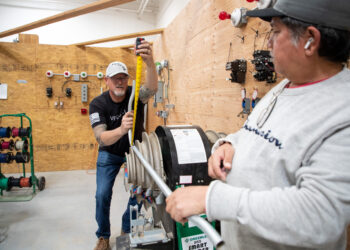
Culinary careers are sizzling again as the hospitality and restaurant industry bounces back from the pandemic and seeks to fill the positions vacated during the COVID-19 downturn. Chaffey College is doing its part to get more cooks in the kitchen.

For students looking for a career in the aviation industry, job prospects are soaring.
“Students now, they’re getting offers from major airlines, even before they graduate,” explains Jack Little, Chaffey College Aviation Maintenance Technology (AMT) professor.
“They’re walking into $70,000 to $80,000 a year right out of school — and that’s just base pay.”
Aviation mechanics and service technicians can expect a 21 percent job growth rate this decade, according to ONET. With such a huge demand, Little says students in the program are in a prime position for career success.
“[Students] could easily make over $100,000 a year if they’re working overtime, and they can pretty much go anywhere they want.
“We cannot put people out the door fast enough to meet the demand of the industry.”
Chaffey’s program is a part 147 training facility, certified by the Federal Aviation Administration (FAA) among 170 accredited schools across the country. Additional Inland Empire/Desert colleges, including San Bernardino Valley College and Victor Valley College, are following their lead with their own aviation maintenance programs.
San Bernardino Valley College offers aviation maintenance students a fully FAA approved curriculum, while Victor Valley College provides internship and work opportunities to prepare students with hands-on experience in the field. After completing their programs, students are ready with the specialized skills to help fill the 270+ regional job openings.
The faculty in Chaffey’s program trains students in everything aviation maintenance technology — from the basics of operating hand tools to performing maintenance on a turbojet aircraft engine. After completing the program, students earn their Airframe and Powerplant certificate, which allows them to perform maintenance on nearly any aircraft.
“Everybody starts from the same place,” Little explains about the program’s structure. “We treat everybody that comes in as if they know nothing about aircraft maintenance.”
“Our program is difficult and very labor intensive,” instructor Christopher Byars adds.
“[Students] should be proud of their accomplishments, and I want them to really feel that, not just at the end of their time here, but after every test they pass, every section they finish, and every project they complete.”
With more aircraft manufacturers incorporating new technology, the demand for trained workers in electronics and aviation systems is skyrocketing — especially following the global pandemic, which triggered a wave of early retirements throughout the aviation industry. This hit left an exponentially large gap of job positions in the field ready to be filled.
“I don’t feel that they anticipated the aviation industry to bounce back as hard as it did,” Little explains. “By getting rid of all of those people that were in the workforce, now there’s even a bigger void, and so now we’re trying to play catchup.”
In response to the high demand, new FAA guidelines were put in place for the program’s curriculum. Students in the AMT program at Chaffey College can now complete the program and earn their Airframe and Powerplant certificate in just a year and a half. Plus, Little makes note of Chaffey College’s partnerships with major airlines that are helping students land a job even before completing the program.
“They contact me and say, ‘send me four names of people you would want to work for you.’ So, a lot of times, two weeks later, [students] are going out to Houston for an interview, or wherever the operating base is,” Little explains.
As former Chaffey College alumni themselves, Little, Byars, and instructor Donnie Guess know what it takes for students to thrive in the program and industry alike. “I graduated from the AMT program at Chaffey College in 2001 and am very thankful that I can give back to the program that has given me so much,” Guess says. Now, he has 20 years of industry experience under his belt and is sharing his wisdom with the next generation of workers.
“I emphasize that the skills [students] are learning will not just lead them to a well-paying job, but a lifelong career,” Guess says. “A career that they can advance to higher levels in and that could possibly take them to many different parts of the world.”
The same praise comes from Professor Little, who graduated from Chaffey’s AMT program in 1987 and then worked in the field on corporate jets.
In addition, Byars harnesses his background in automotive and motorcycle mechanics to relate to students in his courses.
“My experience as a motorcycle and auto mechanic are also helpful, as I find that many incoming students have spent time working on their own vehicles at home,” Byars says. “I can use that experience to relate to many of the concepts and theories that we teach.”
With the instructors’ combined professional background and capability to put themselves in their students’ shoes, the AMT instructors provide a first-class educational experience to those looking for a successful career in the aviation industry.
“We want to see them succeed,” Little proudly begins. “We give the student the tools to go out and be successful.”

Culinary careers are sizzling again as the hospitality and restaurant industry bounces back from the pandemic and seeks to fill the positions vacated during the COVID-19 downturn. Chaffey College is doing its part to get more cooks in the kitchen.

Dual Enrollment (DE) is catching on as students and their families recognize the advantages of earning college credit while still working towards high school graduation. But students aren’t the only… Read More – Good News for Community Colleges: Dual Enrollments Are on the Rise

Enrollment in courses not offering credit toward a degree or certificate are outpacing for-credit programs in some states (Fed Communities). And it’s no wonder. With the convenience, minimal time commitment,… Read More – No Credit, No Problem: Noncredit Courses Gain Steam